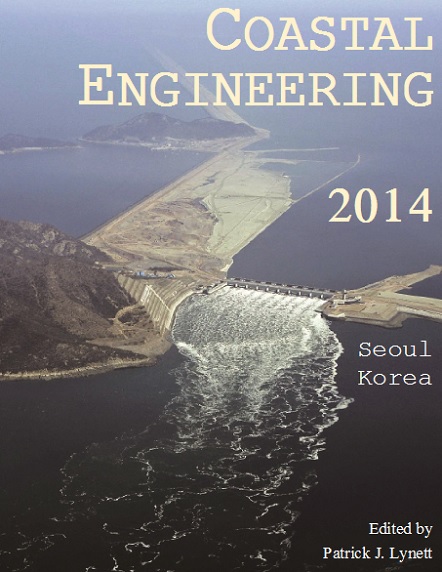Abstract
Tsunami-tide interactions in the Seto Inland Sea (SIS) were investigated by taking into account the effects of tidal currents on the tsunami propagation in terms of the arrival time and the run-up heights along the coast of SIS. The initial tsunami wave profile was introduced by the possible Tokai-Tonankai-Nankai Earthquake of the magnitude Mw9.0, which is equivalent to that of 2011 Tohoku Earthquake. Numerical experiments with four different tidal phases, flood, ebb, high, and low, reveal that the water depth changes due to tides affect the tsunami propagation in terms of heights and arrival time. During high tides, the tsunami propagates faster and reaches higher than during the low tides. In addition, during the flood tides with rising water level, tsunami propagates faster than during the ebb tides. Further investigation also shows that the tsunami-tide interaction changes the tsunami signal such that the tsunami-only spectra shifts the spectral peaks after considering the tsunami-tide interactions. Local oscillation modes characterized by local bathymetry and topography shift to higher frequency modes due to the non-linear tsunami-tide interaction. To reduce the uncertainties involved in tsunami predictions and coastal defenses and management, it is strongly recommended to simulate tsunamis together with tides in shallow water environments.References
Abe, K. 1990. Spectral Characteristics of the 1983 Japan Sea Tsunami Observed in Japan, The science reports of the Tohoku University. Fifth series, Tohoku geophysical journal, 33(2), 97-106.
Abe, T. 1984. Baywater response to tsunamis, Proceedings of 19th International Conference on Coastal Engineering, Houston, Texas.
Androsov, A., J. Behrens, and S. Danilov. 2010. Interaction between tides and tsunami waves, Proc. of the Indian Ocean Tsunami Modelling Symposium, Fremantle, Western Australia.
Furumura, T., K. Imai, and T. Maeda. 2011. A revised tsunami source model for the 1707 Hoei earthquake and simulation of tsunami inundation of Ryujin Lake, Kyushu, Japan, Journal of Geophysical Research: Solid Earth, 116(B2), B02308.
Hatori, T. 1974. Sources of large tsunamis in southwest Japan (in Japanese), J. Seismol. Soc. Jpn., 27, 10-24.
Hatori, T. 1985. Field investigation of historical tsunamis along the east coast of Kyushu, West Japan (in Japanese), Bull. Earthquake Res. Inst. Univ. Tokyo, 60, 439-459.
IOC, IHO, and BODC. 2003. Centenary Edition of the GEBCO Digital Atlas, published on CD-ROM on behalf of the Intergovernmental Oceanographic Commission and the International Hydrographic Organization as part of the General Bathymetric Chart of the Oceans.
Kobayashi, S., J. H. Simpson, T. Fujiwara, and K. J. Horsburgh. 2006. Tidal stirring and its impact on water column stability and property distributions in a semi-enclosed shelf sea (Seto Inland Sea, Japan), Continental Shelf Research, 26(11), 1295-1306.
Kowalik, Z., and A. Proshutinsky. 2010. Tsunami-tide interactions: A Cook Inlet case study, Continental Shelf Research, 30(6), 633-642.
Kowalik, Z., T. Proshutinsky, and A. Proshutinsky. 2006. Tide-Tsunami interactions, Science of Tsunami Hazards, 24(4), 242-256.
Lee, H. S., T. Yamashita, T. Komaguchi, and T. Mishita. 2010. Storm surge in Seto Inland Sea with Consideration of the Impacts of Wave Breaking on Surface Currents, Proceedings of the 32nd International Conference on Coastal Engineering, ASCE, Shanghai.
Lee, H. S., T. Komaguchi, A. Yamamoto, and M. Hara. 2013. Wintertime Extreme Storm Waves in the East Sea: Estimation of Extreme Storm Waves and Wave-Structure Interaction Study in the Fushiki Port, Toyama Bay, Journal of Korean Society of Coastal and Ocean Engineers, 25(5), 335-347.
Lyard, F., F. Lefevre, T. Letellier, and O. Francis. 2006. Modelling the global ocean tides: modern insights from FES2004, Ocean Dynamics, 56(5-6), 394-415.
Murakami, H., T. Shimada, S. Itoh, N. Yamamoto, and J. Ishizuka. 1996. Reexamination of the heights of the 1605, 1707 and 1854 Nankai Tsunamis along the coast of Shikoku Island (in Japanese), J. Jpn. Soc. Nat. Disaster Sci., 15(1), 39-52.
Popinet, S. 2003. Gerris: a tree-based adaptive solver for the incompressible Euler equations in complex geometries, Journal of Computational Physics, 190(2), 572-600.
Popinet, S. 2011. Quadtree-adaptive tsunami modelling, Ocean Dynamics, 61(9), 1261-1285.
Rabinovich, A. B. 1997. Spectral analysis of tsunami waves: Separation of source and topography effects, Journal of Geophysical Research: Oceans, 102(C6), 12663-12676.
Tsuge, T., and T. Washida. 2003. Economic valuation of the Seto Inland Sea by using an Internet CV survey, Marine Pollution Bulletin, 47(1-6), 230-236.
Weisz, R., and C. Winter. 2005. Tsunami, tides and run-up: a numerical study, Proc. of the International Tsunami Symposium, Chania, Greece.
Yamamoto, T. 2003. The Seto Inland Sea--eutrophic or oligotrophic?, Marine Pollution Bulletin, 47(1-6), 37-42.
Yanagi, T., and H. Higuchi. 1981. Tides and tidal currents in the Seto Inland Sea (in Japanese), Proc. 28th Conf. on Coastal Engineering, Japan Soc. Civil Eng., 555-559.
Yanagi, T., H. Takeoka, and H. Tsukamoto. 1982. Tidal energy balance in the Seto Inland Sea, Journal of Oceanography, 38(5), 293-299.
Zhang, Y. J., R. C. Witter, and G. R. Priest. 2011. Tsunami-tide interaction in 1964 Prince William Sound tsunami, Ocean Modelling, 40(3-4), 246-259.

